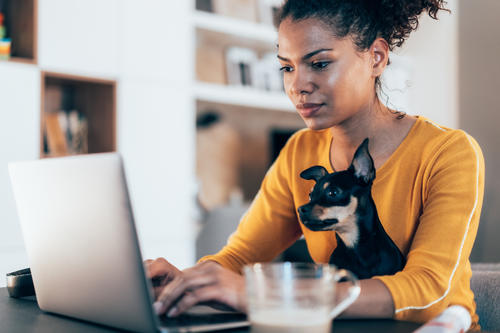
As people begin to head back into the office, dogs and cats that have adjusted to their owners' presence for the last year will have their own set of adjustments to make.
Anxiety at being left home alone can be real for many pets, particularly dogs. Kristi Flynn, DVM, an assistant professor at the Department of Veterinary Clinical Sciences and Dana Emerson, VT, a certified training partner at the Veterinary Medical Center, offer advice on how owners can help decrease their pet’s anxiety during the transition back to the office.
Q. How can people help prepare their dogs for more independence in the coming months?
Dr. Flynn: You can start this by simply leaving the room and going out of sight. There are a lot of dogs that will have some issue with this setup and will want to follow you. You can stop this by giving the dog a favorite toy or food in a puzzle treat just before you depart, then returning before your dog completes his treat. This can teach them that your departure is something good as yummy treats occur when you leave. Work on leaving through the front door with little to no excitement from you at departure. You may need to work up to the point where you can actually open the door and leave without your dog getting worried.
You’ll also want to start extending the time between letting your dog outside to go to the bathroom so that they are trained to expect longer absences.
Q. How can people help prepare their dog for going back in a kennel?
Emerson: If you need to leave your dog kenneled while you are gone, work at getting them comfortable in the kennel. You can start by rewarding them with a treat or something they enjoy every time they go into the kennel. You can also have them go into the kennel to eat each of their meals. Don’t worry about closing the door as you start this transition, as this will help make the kennel a fun and enjoyable place.
Q. What steps can pet owners take to help calm down an anxious pet?
Dr. Flynn: Teach your dog to settle and relax on a mat. If you can teach the dog to self-soothe and calm themself, then the dog can use this skill as a way to lower their anxiety while you’re gone.
Q. What is the best way to greet pets when you come home?
Emerson: Embrace a boring return. When coming home, politely ignore your dog until they have calmed down. Do not talk or interact with your pet when they are overly excited, but if you need to let them outside do this with as little contact and interaction as possible. Once they are back in the house with you and are relaxed, feel free to interact with them.
Q: Will every pet need special attention to adjust to their owners’ return to the office?
Emerson: Every pet is an individual that can have days where they are more or less tolerant of being independent. If your dog prefers being on their own, they may have an easier adjustment when you return to the office. On the other hand, if you have a pandemic puppy that has never been home alone for extended periods, you may have to do all these activities and more to help them adjust.
If things are not going well and your pet is having a difficult time with your absences, contact your local veterinary clinic to discuss your options.
Dana Emerson, BS, VT, is a KPA certified training partner and is at the Veterinary Medical Center.
Kristi Flynn, DVM, is an assistant professor at the Department of Veterinary Clinical Sciences. She is passionate about preventative care; behavior, including the implementation of low-stress handling techniques in the clinic; veterinary dentistry; and nutritional management, particularly the prevention of obesity.
###
About “Talking...with U of M”
“Talking...with U of M” is a resource whereby University of Minnesota faculty answer questions on current and other topics of general interest. Feel free to republish this content. If you would like to schedule an interview with the faculty member or have topics you’d like the University of Minnesota to explore for future “Talking...with U of M,” please contact University of Minnesota Public Relations at [email protected].




